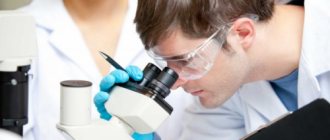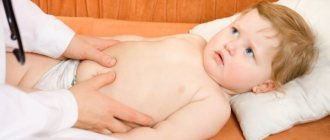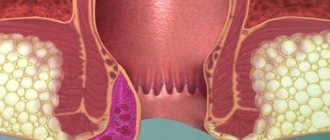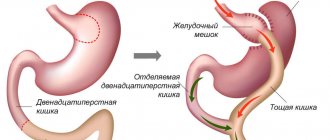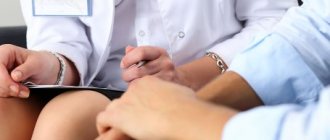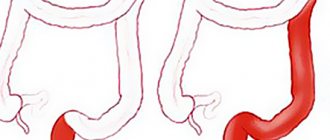Escherichia coli (Escherichia coli, E. coli) is a rod-shaped bacterium belonging to the group of facultative anaerobes (it lives and reproduces only in the absence of direct oxygen).
It has many strains, most of which belong to the natural microflora of the human intestine and help prevent the development of harmful microorganisms and synthesize vitamin K. However, some of its varieties (for example, serotype O157:H7) can cause serious poisoning, intestinal dysbiosis and colibacillosis.
Normal intestinal microflora includes many microorganisms, including lactobacilli, enterococci, streptococci, etc. The strains of these bacteria are in balance, but if the latter is somehow disturbed, pathogenic microorganisms will begin to multiply intensively. At the same time, the processes of fermentation and decay are activated, causing the development of serious diseases.
Some strains of E. coli cause not only diseases of the gastrointestinal tract, but also affect the genitourinary system, provoke colpitis, cystitis, prostatitis, meningitis in infants, and sometimes cause the development of hemolytic-uremic syndrome, peritonitis, mastitis, pneumonia and sepsis.
Functions of E. coli in the human body
E. coli bacteria are essential for human life. This group contains various microorganisms called coliform bacteria.
They make up only one percent of the intestinal microflora and solve a number of important problems:
- perform a protective function, preventing the development of diseases;
- their presence contributes to the proliferation of bifidobacteria and lactobacilli;
- participate in the metabolism of fats and cholesterol;
- participate in the production of vitamins B (the entire group) and K;
- improve the absorption of compounds with iron and calcium;
- strengthen the name system of children (up to 7 years).
The impact of beneficial E. coli is invaluable throughout life, but pathogenic strains of these bacteria provoke diseases, cause poisoning, destroy the beneficial intestinal environment, and have a destructive effect on the immunity of adults and children. In the latter case, this is doubly dangerous, since the fragile child’s body becomes defenseless to the aggressive external environment.
Attention! E. coli is very dangerous during pregnancy: the infection can penetrate the fetus, develop pathologies and lead to miscarriage. E. coli are quite stable; they are able to survive for some time, even if they leave the human body. It helps in medical research and treatment, collecting information through stool, urine analysis, etc.
E. coli is normal
Under normal conditions, E. coli colonizes the human intestine (safe strains), the average amount varies from 106 to 108 CFU/g of distal intestinal contents (CFU - colony-forming unit). The content of E.coli in other intestinal microflora is no more than 1%. Under normal conditions, E. coli take part in the normal functioning of the intestines, synthesizing vitamins K, B1, B2, B3, B5, B6, B9, B12. A very important function is competitive interaction with opportunistic intestinal flora (limiting the proliferation of opportunistic microorganisms).
The non-pathogenic strain Nissle 1917 (Mutaflor) is used for medicinal purposes in children as a probiotic for intestinal dysbiosis. In the intestines, the so-called lactose-positive E. coli are more useful; the content of lactose-negative ones should not exceed 105 CFU/g, and hemolytic E. coli should be completely absent.
The qualitative and quantitative composition of E.coli in the large intestine in healthy people of different ages, both in children under one year old and over 60 years of age, does not differ. For typical E.coli this is 107-108 CFU/g of feces, lactose-negative E.coli <105, hemolytic E. coli are normally absent. The composition of the rest of the intestinal flora differs by age in other respects.
Deviations in the content of non-pathogenic strains of Escherichia coli in the intestine are called dysbiosis and have several degrees.
Degrees of microbiological disorders of E. coli in intestinal dysbiosis
- 1st degree of microbiological disorders: typical Escherichia up to 106-105 CFU/g, it is possible to increase the content of typical Escherichia up to 109-1010 CFU/g.
- 2nd degree of microbiological disorders: increase in the content of hemolytic Escherichia to a concentration of 105-107 CFU/g.
- 3rd degree of microbiological disorders: detection of E. coli in association with other opportunistic microorganisms at a concentration of 106-107 CFU/g and higher.
Pathogenic Escherichia coli
There are more than 100 strains of pathogenic E. coli, which are grouped into 4 classes:
- enteropathogenic E. Coli (ETEC);
- enterotoxigenic E. coli;
- enteroinvasive E. coli (EIEC);
- enterohemorrhagic E. coli (EHEC).
Morphologically they are no different. A feature of pathogenic strains is the ability, when they enter the human body, to produce enterotoxins (thermostable or resistant to high temperatures and thermolabile or rapidly degrading), due to which diarrhea occurs. For example, E. coli O157:H7, which produces similar toxins.
In addition, each group has its own characteristics of the symptoms of the disease.
How can you get infected?
E. coli is transmitted mainly through the oral-fecal route or, less commonly, through household contact.
Through the oral-fecal route of transmission, E. coli gets into the water or soil through feces, as well as onto agricultural plants. Further infection can occur in various ways, for example, when swallowing dirty water, bacteria enter the body and lead to the development of intestinal infections. In other cases, a person touches contaminated plants or soil with their hands and transfers E. coli to food or directly into the body by eating or licking their own hands without first washing them.
Contact and household spread of E. coli is less common and plays the greatest role in the development of outbreaks of escherichiosis in communities, for example, in hospitals, maternity hospitals, kindergartens, schools, families, etc. Through contact and household contact, E. coli can be transmitted from mother to newborn baby when the latter passes through the birth canal contaminated with bacteria. In addition, bacteria can be transferred to various objects (for example, dishes, spatulas, etc.) by unwashed hands, the use of which leads to infection of children and adults.
Causes of pathology
The main reason for the appearance of E. coli is a violation of the intestinal microflora. This is why the pathogenic serotype of Escherichia coli multiplies. The cause of its occurrence is quite often a variety of diseases of the digestive tract. Quite often, the pathological process is diagnosed against the background of pancreatitis, which affects the pancreas. Also, E. coli can appear as a result of the development of intestinal diseases - colitis and enterocolitis. Disruption of the normal intestinal microflora is directly affected by the use of certain pharmaceutical drugs, namely antibiotics.
These traditional medicines suppress microorganisms, eliminating the possibility of pathogenic microflora appearing. Taking antibacterial drugs quite often leads to pathology. A person can become infected with pathogenic strains through the fecal-oral route. Pathology develops when a person fails to comply with hygiene rules during food preparation. If a patient eats unwashed vegetables and fruits, this often leads to the development of E. coli. When watering plants with dirty wastewater after eating them, E. coli may appear.
It is also caused by eating raw milk or undercooked meat. In most cases, E. coli appears due to a person’s unhealthy lifestyle. That is why patients are advised to be attentive to their health.
Symptoms
Signs of a classic E. coli intestinal infection usually develop three or four days after exposure to the bacteria.
Patients report watery diarrhea, dehydration, abdominal cramps, and abdominal pain or tenderness. Nausea and vomiting occur only in some people. Fever is usually accompanied by bloody diarrhea and dehydration. The intestinal mucosa is significantly inflamed.
Patients with Escherichia cholecystitis or cholangitis complain of pain in the right upper quadrant of the abdomen, fever and jaundice. In severe cases, hypotension and neuropsychiatric disorders also develop.
You can get rid of such signs of the disease only under the full supervision of a doctor. Cholecystitis is manifested by fever ({amp}gt; 39°C), chills and can be complicated by a liver abscess.
Patients with intra-abdominal abscesses caused by E. coli may have an elevated body temperature. The spectrum of clinical manifestations ranges from nonspecific findings on abdominal examination to frank septic shock.
People with Escherichia pneumonia usually have fever, shortness of breath, increased respiratory rate, and increased mucus in the bronchi.
www.mayoclinic.org
General deterioration of health and digestive disorders are the main symptoms of E. coli. Intestinal infection can occur as enterocolitis, food poisoning, dysentery or cholera-like infection, hemorrhagic colitis. Symptoms depend on the type of microorganism, so each class needs to be studied in more detail.
This pathogen causes nausea, vomiting, stomach pain, severe diarrhea and high body temperature. The stool is copious and watery. This form of escherichiosis is most often diagnosed in children under one year of age.
Escherichiosis is most often caused by dirty hands, as well as unwashed vegetables and fruits. E. coli is firmly attached to the intestinal mucosa, so the symptoms are pronounced.
Signs:
- copious watery stools;
- paroxysmal abdominal pain;
- nausea and vomiting;
- weakness;
- muscle and joint pain;
- increase in body temperature.
Manifestations of this group of bacteria, Escherichia coli, are often called “traveler's diarrhea.”
Bacteria of this group, E. coli, lead to the most severe consequences. Hemolytic E. Coli causes acute hemolytic anemia as blood cells are destroyed. This can lead to the death of the patient, so it is important to recognize the infection in time.
https://www.youtube.com/watch?v=
Symptoms:
- bloody diarrhea;
- nausea, vomiting;
- lack of appetite;
- weakness;
- headache;
- fever, high body temperature;
- stomach ache.
In children, bacteria of this group of E. coli have characteristics - bloating, liquid feces with mucus and particles of undigested food, regurgitation, vomiting, increased body temperature, tearfulness and restlessness.
Symptoms always appear suddenly and acutely. In addition to the destruction of blood cells, damage occurs to the renal tubules and glomeruli. Ischemia of the vessels of the renal glomeruli develops, and then acute renal failure. As a result of toxic effects, hemolytic jaundice appears, the skin acquires a lemon-yellow tint.
This group of bacteria, Escherichia coli, is more common in children, causing the following symptoms:
- loose stool mixed with blood;
- lower abdominal pain;
- weakness;
- refusal to eat;
- headache;
- increase in body temperature.
What diseases does the infection cause?
Since bacilli most often end up in the gastrointestinal tract, they therefore cause gastrointestinal diseases, as well as intestinal infections (escherichiosis), which are accompanied by symptoms of intoxication.
The following diseases may occur:
- enteritis and hemorrhagic colitis;
- inflammation of the vagina, uterus and appendages;
- prostatitis, orchitis, epididymitis in men;
- colpitis, vulvovaginitis;
- inflammation of the kidneys and bladder;
- urethritis;
- otitis;
- neuritis.
The specific symptoms of E. coli depend on the strain.
Causes
Diarrheagenic E. coli leads to the development of an infectious disease called escherichiosis (intestinal coli infection).
This infection is characterized by symptoms of intoxication and damage to the gastrointestinal tract. The source of infection is patients with escherichiosis, and, to a lesser extent, bacteria carriers. The transmission mechanism is fecal-oral. A person can get coli infection by consuming contaminated food (dairy and meat products, vegetables), water, through dirty hands and care items, toys.
E. coli: symptoms and signs
In the practice of infectious disease doctors, both etiopathogenetic and clinical classifications of Escherichia coli are used. The division of E. coli according to the clinical principle consists of including the main clinical symptom complex in the diagnosis, for example, “gastroenteric E. coli”. In addition, it is imperative to indicate the severity of E. coli, which can vary widely.
Enterotoxic Escherichia coli is a provocateur of the development of pronounced clinical symptoms in children. This type of pathogen is characterized by a short incubation period, at the end of which a pronounced intoxication and dyspeptic syndrome develops, as well as intestinal dysfunction. The danger of E. coli in this situation lies in the tendency to rapid development of dehydration of the child’s body, as well as generalized sepsis, in which the prognosis for recovery is minimal.
When an adult is infected with E. coli, the development of clinical symptoms similar to salmonellosis is most often observed. The incubation period in this situation is no more than three days, and the onset of clinical manifestations is usually acute. The clinical picture of E. coli in adults is not highly specific and manifests itself in the form of headache, progressive weakness, increased body temperature to febrile levels, after which cramping abdominal pain and diarrhea occur. Feces with E. coli, as a rule, contain pathological impurities in the form of mucus and streaks of blood. Infrequent clinical manifestations of E. coli in adults include the appearance of false urge to defecate and tenesmus.
With the cholera-like variant of the course of E. coli, a short period of incubation of the pathogen and moderate signs of intoxication are noted. Symptoms more characteristic of this variant of the clinical course are severe pain in the abdominal cavity, disruption of intestinal activity and increasing dehydration syndrome.
If hemolytic type Escherichia coli enters the human body, the clinical picture of catarrhal-hemorrhagic colitis develops. The duration of active clinical symptoms in this situation is about one week, however, with a complicated course, the development of hemolytic-uremic syndrome may be observed. Characteristic manifestations of E. coli damage to the human body are an increase in neurological symptoms in the form of increased convulsive readiness, muscle rigidity, hemiparesis, and impaired consciousness. With a complicated variant of E. coli, the mortality rate reaches 5%.
Symptoms of Escherichiosis
Escherechiosis is accompanied by symptoms of damage to the gastrointestinal tract. However, the features of the clinical picture depend on which strain the person is infected with.
Thus, escherichiosis caused by enterotoxigenic bacilli occurs mainly in the small intestine, while intoxication is mild. The disease occurs acutely with sudden onset of weakness, weakness, and dizziness. The temperature may be slightly elevated or even normal. In the abdomen (mainly in the epigastrium) diffuse cramping pain occurs. The abdomen is swollen and there is rumbling.
The patient develops diarrhea, stools are profuse, loose, and soon become watery. A person may experience nausea and repeated vomiting. The vomit gradually becomes liquid and whitish. Against the background of profuse vomiting and diarrhea, dehydration develops. The peculiarities of this clinical picture led doctors to believe that the disease was similar to mild cholera. Therefore, escherichiosis caused by enterotoxigenic bacilli is also often called cholera-like.
Escherichiosis, caused by enteroinvasive bacilli, causes damage to the large intestine. The disease develops with the appearance of general intoxication symptoms: weakness, headache, chills, fever. A few hours later, cramping pain occurs in the lower abdomen. Diarrhea occurs, the stool is initially watery and profuse. But as the colon becomes damaged, colitis develops. Symptoms of this condition are frequent loose or pasty stools mixed with mucus and streaked with blood. This variant of escherichiosis is characterized by a benign course. Temperature and stool return to normal after one to three days.
Escherichiosis caused by enteropathogenic bacilli occurs in the form of enterocolitis, and in newborns (especially premature infants) it can become systemic in the form of sepsis. The intestinal form of escherichiosis is characterized by general intoxication symptoms, as well as vomiting, watery yellowish stools with mucus. The septic form of the disease occurs with a much more pronounced intoxication syndrome. The baby's temperature rises greatly, he refuses to feed, vomits, and pustules appear on the skin.
For escherichiosis caused by enterohemorrhagic bacilli, the symptoms of intoxication are mild, the temperature often remains normal. Symptoms of enterocolitis come to the fore: loose, watery stools up to five times a day. Hemorrhagic colitis soon develops, which is accompanied by severe abdominal pain, tenesmus, and loose, bloody stools. Approximately 5% of patients develop dangerous complications after a week in the form of hemolytic-uremic syndrome, as well as thrombocytopenic purpura.
Escherichia coli during pregnancy
In pregnant women, E. coli is often detected in vaginal smears and urine. Moreover, many women say that before pregnancy the bacterium was never found in tests. This does not mean that the woman became infected during pregnancy. On the contrary, the detection of Escherichia coli indicates that a woman has long been a carrier of E. coli, but during pregnancy her immune system can no longer suppress the activity of this microbe, as a result of which it has multiplied so much that it could be detected in tests.
The appearance of bacteria does not mean that a woman is necessarily sick, but indicates that her genital tract or urinary system is contaminated with E. coli, which can provoke an inflammatory process at any time. Therefore, even in the absence of symptoms of the disease, gynecologists treating pregnancy prescribe antibiotics to destroy the bacteria. After all, if E. coli remains in the urine, sooner or later this will lead to pyelonephritis or cystitis in a pregnant woman. If E. coli remains in the vagina, this can lead to colpitis, which, as is known, can provoke premature rupture of amniotic fluid. In addition, the presence of E. coli in the vagina before birth poses a danger to the fetus, since the baby can become infected with the microbe while passing through the mother's birth canal. And such an infection of the baby can lead to the development of serious diseases, such as sepsis, meningitis, otitis media or intestinal infection, which are deadly for the newborn.
Thus, it is obvious that the detection of E. coli in a vaginal smear or in the urine of a pregnant woman requires mandatory treatment, even if there are no symptoms of an inflammatory process in the kidneys, bladder, urethra or vagina.
The norm in urine tests in women, a smear for microflora from the vagina
The human body contains a lot of positive and opportunistic microorganisms that are necessary for its normal functioning and the proper functioning of the immune system? synthesis of vitamins and a number of other necessary substances.
But sometimes these bacteria can be dangerous, especially if they get into areas of the body where they shouldn't be. Often this situation concerns a microorganism such as E. coli.
E. coli was found in a woman's smear: what are the causes and treatment of this condition, what to do if an infection is found in a pregnant woman and how to cure it without harming the fetus? Everything is detailed and accessible in our article.
What it is
The microorganism was isolated back in 1885. Today many of its varieties are known. Their mass is harmless and necessary for the intestinal microflora. Escherichia coli is involved in the synthesis of a number of vitamins: K, group B.
- But there are more than a hundred types of pathogenic microorganisms that can cause serious illness or poisoning.
- Even opportunistic bacteria, getting from the intestines to other organs, can pose a danger.
- The normal habitat of the stick is the area of the large intestine located closer to the anus.
- In small quantities, this bacterium is present in the vagina, but when it multiplies, it leads to problems - bacterial vaginosis and others.
Detection methods
Most women are examined once a year at the antenatal clinic. While examining the genitals, the gynecologist takes material - a smear on a piece of glass. This material is then sent to a laboratory where it is examined in detail.
A smear test allows you to determine how healthy the local microflora is. Analysis under a microscope and with chemical reactions makes it possible to identify E. coli in the taken material.
Reasons for appearance
Reasons why a microorganism can enter the vagina:
- Poor hygiene, improper washing. The vagina and anus are located nearby, so you need to wash yourself not from bottom to top, but from top to bottom to prevent the introduction of pathogenic microbes.
- Wrong underwear. Microorganisms can get into the vagina due to wearing tight underwear and thongs. Many people like the latter - it’s beautiful, sexy, but it’s still better not to abuse them, choosing health over beauty. It’s worth choosing underwear made from natural materials.
- Unprotected sex. You can get E. coli through combined anal-vaginal contact. Therefore, lovers of variety in bed need to be careful about protective equipment. The risk of E. coli getting into the smear increases with a constant change of sexual partners, weakened immunity and frequent douching.
The first signs of the presence of E. coli in a smear may appear a day or even a week after it enters. Characteristic symptoms:
- severe diarrhea;
- heat;
- vomiting with greenish impurities;
- unpleasant pulling sensations in the stomach;
- constant nausea;
- lack of appetite;
- general malaise.
Symptoms usually disappear on their own within a couple of days. The reason for this is the spontaneous sanitation of the intestines. But if this condition does not go away for more than two days, consult a doctor.
If E. coli was detected in a vaginal smear, this is a serious reason to start treatment as early as possible. Of course, only a doctor can describe his tactics correctly. Antibacterial drugs are mainly used.
Sometimes local therapy is sufficient, but if the lesion is quite serious, more thorough treatment is required. Antibacterial correction is carried out on the basis of an antibiogram of the identified pathogen.
Often drugs from the fluoroquinolone group are used - Levofloxacin or Ciprofloxacin. The required dosage and duration of treatment is determined only by the doctor. Do not self-medicate under any circumstances, as this may cause the microorganism to become resistant to antibiotics.
Consider popular antibacterial drugs:
- Monural. Available in the form of a colorless granular powder, which must be taken after dissolution with water. The effect is determined by the presence of phosphonic acid derivatives. This remedy is a broad-spectrum antibiotic and can be prescribed to pregnant women. It is usually recommended to take 3 grams once a day. If the infection is severe, the drug may be combined with other antibiotics.
- Suprax. Available in capsule form. The main active substance is cifixime. Used for a number of infections, in particular E. coli. It is often prescribed together with Canephron, which simultaneously protects the urinary tract from infections. This is a strong antibiotic.
- Fosmicin. Also applies to broad-spectrum antibacterial drugs, an absolute analogue of Monural. Contraindications include pregnancy, age under 12 years. If the lesion is serious, symptoms of inflammation appear, there is a risk of intrauterine damage, this remedy is also prescribed to pregnant women with careful supervision of a specialist.
Preferred formulations also contain an epithelial repair component. The use of Gynoflor vaginal tablets gives good results.
To restore the microflora, the drugs Ecofomin and Vagilak can be used. Normoflorin is indicated for oral use.
If E. coli is present in the smear, local treatment is sometimes sufficient. It involves regular hygiene of the external genitalia.
- Sometimes doctors advise using various herbal infusions instead of pharmaceuticals, for example, chamomile infusion.
- Therapy may involve therapeutic douching.
It is often recommended to administer vaginal suppositories that have antiseptic properties. Suppositories with nystatin are used. You may receive a recommendation to inject a 20% borax solution into the vagina.
Vaginal suppositories can be prescribed Lactobacterin or Bifidumbacterin. Sometimes sessions of ultraviolet irradiation of the genital area are required.
Sometimes folk remedies really help. However, before using them, you need to consult a gynecologist so as not to harm yourself. The following methods are popular among people:
- Jerusalem artichoke. Several Jerusalem artichoke fruits need to be thoroughly washed and peeled. Cook until tender, then drain the resulting broth. Cut the fruits into pieces and pour kefir or sour cream (any fermented milk product will do). The resulting broth can also be drunk, adding a small amount of sour cream and salt. You need to eat the prepared dish once a day until the symptoms of the problem disappear. Please note that this measure can be used in complex therapy, but it alone will not cope with the infection.
- Kefir lotions. The beneficial fermented milk environment has a detrimental effect on E. coli, so it is often recommended to use kefir, natural yogurt, and sour cream. You can make lotions with kefir. Take a sterile bandage or cotton wool, soak them well in a fermented milk product. Place the compress in your underwear and put it on. Lie like this for 10 minutes, then rinse your genitals well with clean water. Repeat for a week.
- Chamomile or calendula for washing. This measure will not help eliminate the microorganism itself, but will eliminate the symptoms of the lesion and wash away dead organisms from the mucous membranes and genitals. Take 20 g of herbs, pour boiling water over them. Cover the container well with a lid and let it cool. Then strain the grounds well and use the broth for washing. 7-10 procedures will be enough.
Does a partner need treatment if a woman's smear shows E. coli?
The issue of detecting a microorganism in a smear in pregnant women should be considered separately. At this time, the expectant mother’s body and her immunity are weakened, so the likelihood of various infections occurring is very high.
- The bacillus can cross the placenta and infect the baby, which can cause meningitis.
- The baby can become infected while passing through the birth canal.
E. coli can cause vaginosis, which can cause premature birth. Pregnant women also need to be careful with antibiotics. Under no circumstances take any medications without the permission of a specialist.
You need to go to the doctor as soon as possible - he will help you choose medications that will be safe for the development of the fetus, but will be able to normalize the microflora.
Prevention measures
Simple preventive measures will help prevent E. coli from entering the vagina:
- Wash yourself at least twice a day.
- Change your underwear every day.
- Wear the right underwear, try to avoid thongs and choose panties made from natural materials.
- Use protective equipment during intimate contact, and be careful when choosing sexual partners.
E. coli can cause a number of problems. But even if it is discovered, there is no need to panic. The main thing is to go to the doctor in a timely manner and begin treatment, avoiding dubious amateur activities.
There are several reasons for the development of pathology. It is possible to determine and establish the exact nature of the origin of the disease only after consultation with a specialist and passing all the necessary examinations.
Physiological
The disease develops against the background of violation of personal hygiene rules, during sexual intercourse, as well as through infection from a carrier or potentially dangerous household items.
Causes:
- insufficient treatment (washing) of the genitals or the use of low-quality personal hygiene products to care for the genitals;
- violation of genital care techniques;
- use of uncomfortable or low-quality underwear;
- touching the genital area with dirty hands;
- specific types of sexual intercourse - anal sex;
- sexual transmission of infection;
- a large number of sexual partners;
- lack of protection during sexual intercourse.
In this case, women are mostly affected by the disease. The number of infection carriers among women is 4-5 times higher than the number of infected among men.
Pathological
The main provoking factor in the development of the disease is the structural feature of the urinary system in women. The anus is located close to the urethra, which greatly increases the risk of penetration (migration) of pathogenic microflora.
Escherichia coli in infants
When testing for dysbacteriosis or coprogram (scatology), two types of E. coli are often found in the stool of infants - hemolytic and lactose-negative. In principle, hemolytic Escherichia coli should not be present in the feces of either an infant or an adult, since it is a purely pathogenic microbe and causes intestinal infections that occur as hemorrhagic colitis.
However, if hemolytic E. coli is detected in an infant, you should not rush to start treatment with antibiotics. To understand whether your baby needs to be treated, you should objectively assess his condition. So, if a child gains weight normally, develops, eats well and does not suffer from watery yellow stool that literally streams out of the child’s anus, then there is no need to treat the baby, since therapy is necessary only if there are symptoms, and not numbers in the tests. If a child loses or does not gain weight, or suffers from watery, yellow, foul-smelling stool that comes out in a stream, then this indicates an intestinal infection, and in this case, the E. coli detected in the tests must be treated.
Lactose-negative Escherichia coli may well be present in the feces of a baby, since it is a component of normal microflora, and normally can account for up to 5% of the total amount of all Escherichia coli present in the intestines. Therefore, the detection of lactose-negative Escherichia coli in the stool of a baby is not dangerous, even if its quantity exceeds the norms indicated by the laboratory, provided that the child is gaining weight and developing normally. Accordingly, there is no need to treat lactose-negative Escherichia coli detected in tests on an infant if it is growing and developing. If the baby does not gain or loses weight, then lactose-negative E. coli needs to be treated.
Diagnostics
When an intestinal infection occurs, the method of diagnosing the disease is of utmost importance, which will help determine the specific type of bacteria, find the correct method of treatment and take timely action.
- A method of bacteriological research, which is carried out using the inoculation of various materials:
- if the intestines are damaged, stool or vomit is analyzed;
- in case of damage to the urinary tract, urine is analyzed;
- in case of infection of the genital organs, a smear or scraping from the mucous membrane is taken.
Materials are placed in special environments in which microorganisms multiply; they are then tested for sensitivity to antibiotics. This helps the doctor prescribe the most effective medications for treatment.
- The research method using special medications involves the use of ultrasound, urography, etc.
- The method of general clinical research is widespread. It does not detect pathogenic bacteria, but can confirm the presence of inflammation in stool, urine, pus or blood. Used as an additional diagnostic method.
Microorganisms appear in the genitourinary system during anal sex and failure to comply with basic hygiene rules. Bacteria enter the urinary tract from the intestines, become attached to them and are not completely washed out when urinating.
E. coli bacteria, when found in urine, are not a sign of infection. This may be a manifestation of pathological changes in the urinary system.
E. coli in a smear in women is a consequence of:
- wearing tight underwear;
- unprotected anal sex;
- failure to comply with hygiene rules.
During pregnancy, the presence of pathogenic bacteria is risky for the baby. E. coli in the vagina can pass to the baby during childbirth and cause meningitis.
Attention! The mother's immune system cannot enter the fetus through the placenta and protect it. Before giving birth, women need to undergo appropriate and careful treatment.
Diagnosis of infections
The most common way to identify a microorganism is the bacteriological method - inoculating material on special media. If an infection is suspected, the laboratory identifies the pathogen and determines its sensitivity to antibiotics. If Escherichia coli is detected in the culture in quantities exceeding the norm, the corresponding degree of microbiological deviation is established. An increased level of Escherichia coli is called bacteriuria. In the case of an asymptomatic course of the pathology, the diagnosis is made in the presence of microorganisms in quantities of 105 or more CFU/ml of material. A lower bacterial count is considered a sign that the urine is contaminated at the time of collection (contamination). If the symptoms are severe, the presence of E. coli in the amount of 102-104 CFU per milliliter is sufficient to make a diagnosis.
Escherichia coli in urine and smears
If personal hygiene rules are not followed, as well as during sexual intercourse, E. coli can penetrate the vagina. In the future, this microorganism provokes the development of vaginitis and colpitis, and with a decrease in immunity, the bacterium is able to penetrate the urinary organs and cause inflammation (cystitis, pyelonephritis).
To diagnose diseases of the genitourinary system, it is necessary to conduct a urine test. However, the presence of E. coli in the urine does not always indicate the presence of a disease. Bacteria found in small quantities may mean that the woman did not perform proper hygiene procedures before taking the test. However, if a urine test detects at least 102-104 E. coli in the presence of symptoms of the disease, this indicates an inflammatory process occurring in the kidneys or bladder.
In men, E. coli is often the cause of prostatitis, orchitis or epididymitis.
The appearance of a pathogen in the prostate in men
Damage to the urogenital system most often manifests itself in the form of low-grade fever and dysuria. Urinary disorders in men are characterized by increased frequency and pain.
Patients with acute Escherichia prostatitis or prostate abscess complain of chills, sudden fever (<39°C) and pain in the perineum or back. The prostate gland is sensitive to touch, swollen, hardened and hot.
Acute prostatitis also manifests itself in the form of dysuria, urgent and frequent urination. Some people may have myalgia, urinary retention, malaise, and arthralgia. If the patient does not respond to antibiotics, there may be a gland abscess, which can be detected through various tests.
How to treat E. coli in the prostate? Treatment consists of open surgical or dermal drainage. Patients with prostatic abscess caused by Escherichia coli have a high fever despite adequate antibiotic therapy and gland mobility on rectal examination.
Patients with concomitant bacterial pyelonephritis present with localized pain in the flank or lower back, high fever (<39°C) and dysuria.
The condition may be complicated by a necrotizing abscess that does not respond to antibiotics. Patients with diabetes or urinary tract obstruction may develop bacteremia and sepsis. Disease of the digestive tract is no less dangerous.
How to treat E. coli?
Treatment of intestinal infections caused by coli is usually complex and includes the following points:
- Antibiotics. Antibacterial therapy forms the basis of treatment for E. coli. A particular drug is prescribed after determining the sensitivity of microorganisms to it. The most commonly recommended antibiotics are the cephalosporin group: Cephelim, Cephalexin, Levofloxacin. The drugs are taken in courses of 5-10 days. The course cannot be interrupted or the dosage exceeded without the doctor's permission.
- Bacteriophages. These are drugs that kill bacteria more gently and safely than antibiotics, but they are not always effective. Essentially, bacteriophages are viruses that live and reproduce only in the presence of certain bacteria. These viruses exist at the expense of bacteria, destroying them. Bacteriophages include Sextaphage, Intesti-bacteriophage, etc.
- Painkillers. If the abdominal pain is severe, painkillers such as No-shpa, Bral, Spasmalin, Nurofen are prescribed. However, they should not be taken for a long time.
- Probiotics. Probiotics (Linex, Bifidumbacterin, etc.) help restore the normal balance of pathogenic and beneficial microorganisms in the intestines.
Treatment and dosage of drugs must be prescribed by a doctor. Self-medication can be dangerous, especially during pregnancy or early childhood.
Treatment
How to get rid of E. coli? The extent of medical care depends on the severity of the infection. In addition to antibiotics, supportive care should be provided: fluid replacement, adequate oxygenation (treating E. coli with oxygen), and blood pressure support if required. Surgical debridement may be performed in patients with intra-abdominal abscess, cholecystitis, or cholangitis.
Meningitis requires antibiotics such as third-generation cephalosporins (eg, ceftriaxone).
Escherichia pneumonia requires respiratory support (supply of a humidified oxygen mixture) and antibacterial drugs (fluoroquinolones).
Cholecystitis and cholangitis require antibiotics such as third generation cephalosporins. For intra-abdominal abscess, antimicrobial agents should also include: ampicillin and sulbactam or cefoxitin. For severe infections, piperacillin tazobactam, imipenem-cilastatin, or meropenem may be used.
Intestinal Escherichia infections require replacement therapy - parenteral administration of fluid solutions containing the necessary electrolytes. Antibiotics include doxycycline, trimethoprim, fluoroquinolones, and rifaximin. They reduce the duration of diarrhea by 24-36 hours.
Patients with concomitant diseases (for example, diabetes) should take a course of levofloxacin or aztreonam for 7-14 days.
It is unacceptable to treat E. coli on your own. The symptoms of escherichiosis are similar to other infectious diseases, so it is impossible to select adequate therapy at home. All medications are prescribed only after the results of bacterial culture. Treatment of E. coli is possible only with the help of antibacterial drugs.
Basic medical measures for escherichia coli:
- hospitalization (for young children and patients with dehydration);
- bed rest;
- drug therapy (antibiotics, probiotics, detoxification agents, rehydration);
- dietary nutrition (diet No. 4 for intestinal damage and table No. 7 for diseases of the kidneys and genitourinary system).
Drug therapy is primarily aimed at preventing dehydration of the body, maintaining vital functions and preventing complications from the gastrointestinal tract and genitourinary system.
Treatment of escherichiosis with medications looks like this:
- cephalosporin and fluoroquinolone antibiotics - Levofloxacin, Moxifloxacin, Cefaprim, Cefazolin, Cefepime;
- bacteriophages (preparations containing viruses that kill E. coli) – Liquid coli;
- probiotics (required for dysbacteriosis) – Hilak forte, Linex, Acipol, Enterol;
- enterosorbents (to relieve symptoms of intoxication) – Smecta, Enterosgel, Polysorb;
- rehydration solutions (for the prevention of dehydration caused by vomiting and diarrhea) – Trisol, Regidron;
- antipyretic drugs (at temperatures above 38 ° C) - Paracetamol, Panadol, Ibuprofen.
Bacteriophages have a pronounced therapeutic effect. They kill the pathogen escherichia coli, so recovery occurs faster than with antibacterial therapy.
Severe dehydration, which is accompanied by electrolyte disturbances, is treated with infusion solutions.
Antibacterial treatment lasts 5-7 days. After recovery, the patient should take probiotics, for example, Bifidumbacterin, for 2-3 weeks, and also follow a diet.
Consequences
Escherichia coli can cause disease in organs other than the intestines. In the urinary tract, this bacterium can also cause inflammation. In girls and women, this risk is higher than in men, because... they have a short path from the intestine to the urethra.
In addition, the bacterium is often the culprit of respiratory infections, the cause of neonatal meningitis (inflammation of the brain), etc. These conditions apply mainly to weak and long-term bedridden people.
Treatment for intestinal infections often consists only of fluid replenishment, diet, and supplementation of appropriate bacteria that prevent E. coli from multiplying. Antibiotics have been found to increase the secretion of toxin from bacteria, so it can sometimes be difficult to decide on a specific treatment option. In case of inflammation of other organs and tissues, treatment always involves the use of antibiotic drugs.
Prevention
E. coli is destroyed during cooking, baking, and pasteurization. However, this rule applies provided that the temperature is at least 70°C and the process continues for at least 2 minutes. Unlike others, the E.coli bacterium is characterized by resistance to cold, acidic environments, drying and high salt concentrations.
Preventative actions to prevent diseases caused by E. coli:
- Use of disposable clothing in hospital settings.
- Monitoring the hygiene and health of pets.
- Maintain personal hygiene: thoroughly wash your hands and face after going outside and in crowded places, a competent approach to intimate hygiene.
- Monitoring the purity of consumed raw products and bringing milk and meat to the desired state.
- Drink only high quality water.
- Regular cleaning of residential premises using reliable but not aggressive detergents.
- Be careful when eating in public catering establishments and while on vacation in hot countries.
Intestinal infection in children Intestinal dysbiosis Irritable bowel syndrome Intestinal colitis Intestinal cancer Crohn's disease
Escherichia coli and the genitourinary system
E. coli, entering the organs of the urinary or reproductive system, leads to diseases of these organs. Common diseases caused by E. Coli:
- cystitis;
- pyelonephritis;
- urethritis, prostatitis, epididymitis and orchitis in men;
- adnexitis, vulvovaginitis, endometritis, colpitis in women;
- peritonitis.
Escherichia coli penetrates from the rectum into the urethra and bladder in an ascending manner. There are suggestions that the bacillus is transmitted sexually from an infected partner.
Infectious diseases caused by E. coli are difficult to treat. The bacterium weakens local immunity, which makes there a high probability of infection with gonococci, staphylococci and other dangerous microorganisms. Chlamydia or gonorrhea may develop.
Along with genitourinary diseases, complications from the digestive tract are possible, for example, pyelonephritis is often accompanied by acute pancreatitis.
